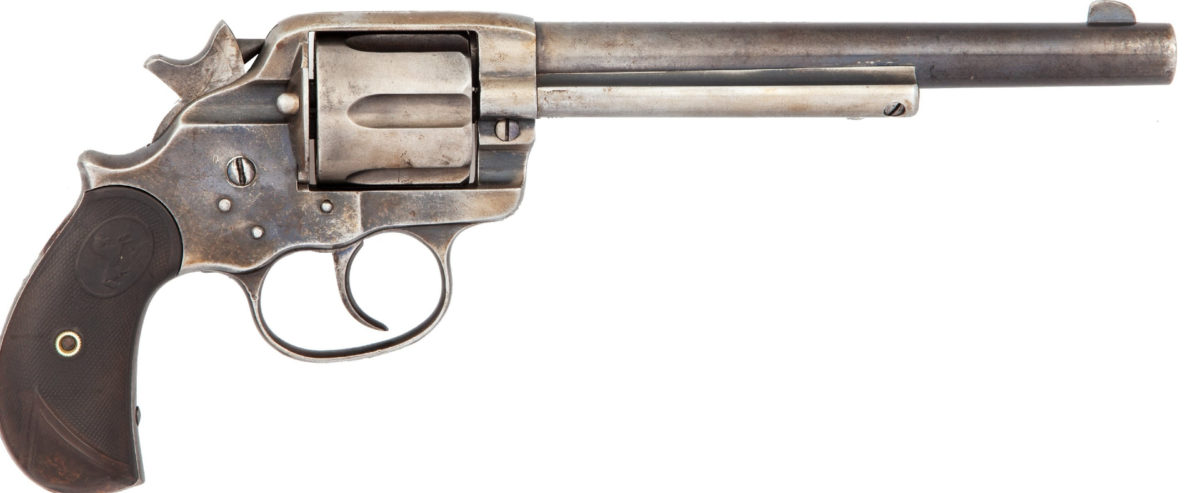When Sam Colt invented the first American revolver that worked when it was supposed to, one of the keys to its success was that its single-action, cap-and-ball mechanism had only four moving parts. Although Colt had experimented with double-action (i.e., self-cocking) revolvers, he died on January 10, 1862, without ever having put one into production. His logic was simple. First, a double-action revolver required more moving parts, which increased production costs. Second, more moving parts meant a greater chance a part could break or fail, and that could prove fatal to a frontiersman who staked his life on the dependability of his six-shooter.
Before a shooter can fire a single-action revolver, he must manually cock the hammer, which also revolves the cylinder; a squeeze of the trigger then releases the hammer and fires the gun. Just squeezing the trigger will not fire a single-action revolver. On the other hand, a squeeze on the trigger of a double-action revolver revolves the cylinder, cocks the hammer, releases the hammer and fires the gun all at once—no manual cocking required.
Due to Sam Colt’s negativity regarding double-action revolvers, the Colt factory didn’t produce one until 1877, well into the cartridge era. Its first double-action revolver was the small-framed, six-shot Lightning—in .32 and .38 calibers, as well as a .41-caliber version, also marketed as the Thunderer. But the need out West for bigger-caliber, man-stopping weapons prompted Colt to create the Model 1878 Frontier Double-Action. Colt revamped the Lightning into a larger-framed, six-shot, double-action revolver that utilized the same barrel, ejector housing and cylinder as the widely popular Colt Single-Action Army model. The result was an ugly-looking, bird’s head–gripped Colt with a European look and feel that drew complaints from veteran gun handlers on the frontier. Worse, because of its weak mainspring, the Model 1878 sometimes misfired, leaving its owner very dead after a gunfight. Furthermore, as with the Lightning, when the Model 1878’s fragile locking-bolt spring broke, gunsmiths threw fits trying to put its mechanism back together. Despite these problems, the Model 1878 earned plenty of early praise, especially from U.S. Army officers who used them as personal sidearms during the Indian wars of the Southwest.
GET HISTORY’S GREATEST TALES—RIGHT IN YOUR INBOX
Subscribe to our Historynet Now! newsletter for the best of the past, delivered every Wednesday.
The Model 1878 was available in almost any caliber or barrel length, though .45 and .44-40 calibers were the most popular, and 4 ¾-, 5- and 7 ½-inch barrel lengths were standard. The standard finish was blue, and the standard stocks were of hard rubber. Other types of finishes, all styles of engraving and pearl or ivory grips (plain or carved) were optional and cost extra. B. Kittredge & Co. of Cincinnati, one of Colt’s biggest dealers, nicknamed the Model 1878 the “Omnipotent” to boost its sales appeal.
The Model 1878 is seldom mentioned in 19th-century gunfight accounts, in part because newspaper reporters didn’t know the proper terminology to describe it. For example, when Doc Holliday shot and wounded saloon owner Milt Joyce and his partner in Tombstone, Arizona Territory, on October 10, 1880, newspapers only described Doc’s revolver as a “self-cocker.” Not knowing about the Model 1878, many historians assume Doc’s gun was a Lightning, and it could have been. But it also could have been a Model 1878 or a European double action.
Thanks to the dedicated research of both Don Wilkerson (Colt’s Double-Action Revolver, Model of 1878) and Charles Worman (Gunsmoke and Saddle Leather: Firearms in the 19th-Century American West), the names of some Old West characters who bought or carried the Model 1878 have come to light. In late 1878, U.S. Marshal Daniel P. Upham, stationed at Fort Smith, Ark., bought one in .45 caliber with ivory grips, and the next summer he bought seven more .45s. George Maledon, hangman for Isaac “the Hanging Judge” Parker, carried a Model 1878, now on display at Fort Smith. Other Model 1878 owners included gambler “Rowdy Joe” Lowe, Captain Jack “the Poet Scout” Crawford and Apache-campaign scouts Tom Horn and Al Sieber. Worman writes: “Buffalo Bill Cody special ordered two .45s with a nonstandard 9-inch barrel in 1888, and gun dealer J.P. Lower of Denver advertised a variation of the M1878 with a 4-inch barrel, which he designated as the ‘Sport’s Pet.’ Famed Arizona lawman Jeff Milton apparently sometimes carried an M1878 .44 with a 4-inch barrel in a hip pocket leather holster.”
In the early 1880s, Deputy U.S. Marshal W.R. McFarland of Austin, Texas, bought two silver-plated Model 1878s, one in .45 caliber with ivory grips and the other in .41 caliber with pearl grips. Cody’s Wild West show partner Gordon “Pawnee Bill” Lillie special ordered two Model 1878 Colts in 1893. Les Snow, a Wyoming deputy sheriff who helped convict hired killer Tom Horn, owned an engraved Model 1878, now on display at the University of Wyoming in Laramie. Two Army officers who carried Model 1878s on the Southwestern frontier—1st Lt. Marion Perry Maus and Captain Francis Safford Dodge— received the Medal of Honor for “most distinguished gallantry.” And a Model 1878 recently turned up with an inlaid silver plaque on its left grip that reads, PRESENTED TO BOB SPECK, SHERIFF, SPOKANE CO., BY LOU HUNT. Speck was a deputy sheriff and acting sheriff in Missoula, Montana Territory, in the early 1880s and sheriff of Spokane County in Washington Territory in 1898–99.
Besides mechanical problems, one other factor rang the death knell for the Model 1878 Colt. In those early days when double-action revolvers were still a novelty, most gunmen were accustomed to rapid firing their single-action revolvers by “fanning” the hammer while keeping steady pressure on the trigger. But with the Model 1878, a shooter had to completely release the trigger after each shot, then squeeze it again to reengage the double-action mechanism, revolve the cylinder and cock the hammer for another shot. If a man who lived by the gun didn’t retrain himself to release the trigger of the Model 1878 before squeezing off his next shot, his first shot would be his last, giving him but a split second to wonder why his new six-gun had failed him.
Colt rolled out some 51,200 Model 1878s before throwing in the towel and ceasing production in 1905 in favor of its big New Service Model 1898 swingout-cylinder revolvers. Ever since, the Model 1878 has remained the black sheep of Colt revolvers from the “shoot- ’em-up” period of the Old West.

this article first appeared in wild west magazine
Facebook @WildWestMagazine | Twitter @WildWestMag





